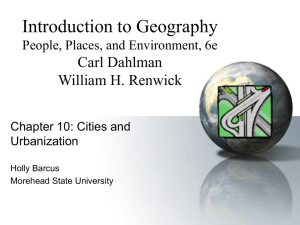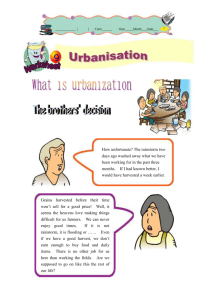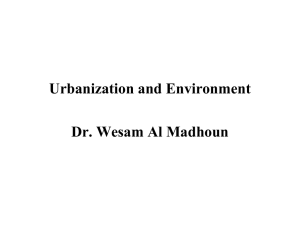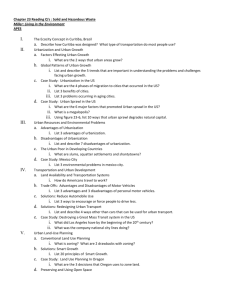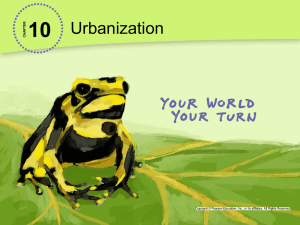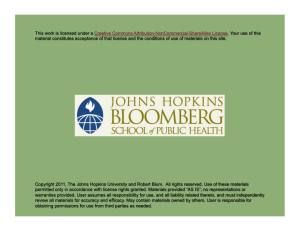Urban heat island
advertisement
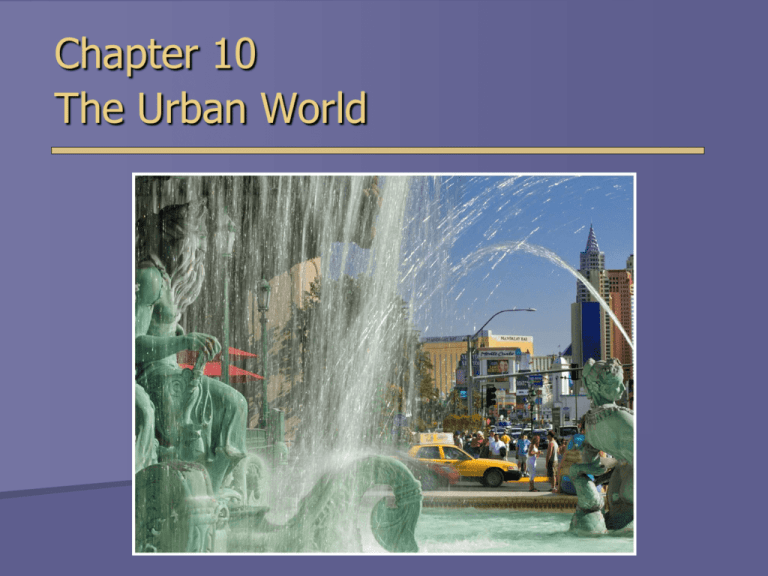
Chapter 10 The Urban World Population and Urbanization Milestone: As of 2008, half of the world’s population lives in urban areas Population and Urbanization Urbanization Process in which people increasingly move from rural to urban areas Social unrest Tenure issues Looking for jobs Jobs define urban vs. rural, not populations People are moving to cities due to decrease in employment opportunities in rural areas Characteristics of Urban Population Basic characteristics of city populations: Diverse population Younger population than local rural area More males in developing nation cities More females in developed nation cities Urbanization Trends Urbanization is increasing rapidly Especially in developing countries World’s 10 largest cities are in developing countries Urbanization Trends Urban Agglomeration megacities Substandard Housing Typically occupied by squatters No city services Water, sewage, garbage collection, police and fire protection 1/3 of urban population in developing countries are squatters Cities are dynamic open systems Environmental Problems in Urban Areas Growing urban areas affect land use patterns Impermeable surfaces and urban runoff discharged into waterways Fragment wildlife Encroach wetlands, forests, desert, etc. Motor oil, lawn fertilizers, heavy metals Noise pollution Environmental Problems in Urban Areas Brownfields Urban areas of abandoned industrial or residential sites that may be contaminated from past use Environmental Problems in Urban Areas Long commutes Buildup of emissions due to cars and industry Urban heat island Local heat buildup in an area of high population density Contribute to buildup of pollutants- dust domes Urban Heat Island Temperature variations on a summer afternoon Environmental Benefits of Urbanization Well-planned city can benefit the environment Reduces pollution Preserves rural areas Compact Development Design of cities where residential buildings are close to shopping, jobs and public transportation Transportation and Urban Development Transportation availability affects city’s spatial structure Ex: An east coast US city Suburban Sprawl Suburban Sprawl Patchwork of vacant and developed tracts around the edges of cities Problems Loss of wetlands Air & water pollution Loss of biological habitat Suburbia: Where they tear out trees and then name streets after them Suburban Sprawl Smart Growth: urban planning and transportation strategy that mixes land uses Commercial Manufacturing Entertainment Housing Making Cities More Sustainable Characteristics of a sustainable city Clear, cohesive urban growth policies Efficient use of energy and other resources Reduction of pollution and waste Large areas of green space Designed to be people-centers, not carcentered Food grown IN the city (rooftop gardens) Compact development Copenhagen, Denmark A People-centered City Green Building Design Orientation of the house Green energy (solar) Reclaimed materials Recycled water or water saving Low or no VOC’s Compost bins Green roof Lunar/solar tubes Sustainable Cities Case in Point - Curitiba, Brazil


